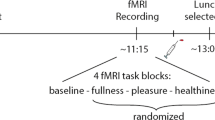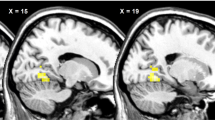Abstract
Background/Objectives
Obesity is associated with unhealthy food choices. Food selection is driven by the subjective valuation of available options, and the perceived and actual rewards accompanying consumption. These cognitive operations are mediated by brain regions including the ventromedial prefrontal cortex (vmPFC), dorsal anterior cingulate cortex (dACC), and ventral striatum (vStr). This study investigated the relationship between body mass index (BMI) and functional activations in the vmPFC, dACC, and vStr during food selection and consumption.
Subjects/Methods
After overnight fasting, 26 individuals (BMI: 18–40 kg/m2) performed a food choice task while being scanned with functional magnetic resonance imaging (fMRI). Each trial involved selecting one beverage from a pair of presented options, followed by delivery of a 3 mL aliquot of the selected option using an MR-compatible gustometer. We also tracked subjective preference for each beverage throughout the experiment.
Results
During food choice, individuals with greater BMI had less activation in the dorsolateral prefrontal cortex when selecting a high-value option and less vmPFC activation upon its consumption. Independent of BMI, during food choice the dACC and anterior insula elicited higher activation when a less preferred beverage was selected. Activation of the dACC and a broader frontoparietal network was also observed when deciding between options more similar in value. During consumption, receipt of a more preferred beverage was associated with greater vmPFC response, and attenuation of the dACC.
Conclusions
An individual’s preference for a food option modulates the brain activity associated with choosing and consuming it. The relationship between food preference and underlying brain activity is altered in obesity, with reduced engagement of cognition-related regions when presented with a highly valued option, but a blunted response in reward-related regions upon consumption.
This is a preview of subscription content, access via your institution
Access options
Subscribe to this journal
Receive 12 print issues and online access
$259.00 per year
only $21.58 per issue
Buy this article
- Purchase on Springer Link
- Instant access to full article PDF
Prices may be subject to local taxes which are calculated during checkout





Similar content being viewed by others
References
Rangel A. Regulation of dietary choice by the decision-making circuitry. Nat Neurosci. 2013;16:1717–24. http://www.nature.com/doifinder/10.1038/nn.3561.
De Araujo IE, Schatzker M, Small DM. Rethinking food reward. Annu Rev Psychol. 2020;71:24.1–24.26.
Stice E, Figlewicz DP, Gosnell BA, Levine AS, Pratt WE. The contribution of brain reward circuits to the obesity epidemic. Neurosci Biobehav Rev. 2013;37:2047–58. https://doi.org/10.1016/j.neubiorev.2012.12.001.
Stice E, Burger K. Neural vulnerability factors for obesity. Clin Psychol Rev. 2019;68:38–53. https://doi.org/10.1016/j.cpr.2018.12.002.
van Meer F, Charbonnier L, Smeets PAM. Food decision-making: effects of weight status and age. Curr Diab Rep. 2016;16. https://doi.org/10.1007/s11892-016-0773-z.
Val-Laillet D, Aarts E, Weber B, Ferrari M, Quaresima V, Stoeckel LE, et al. Neuroimaging and neuromodulation approaches to study eating behavior and prevent and treat eating disorders and obesity. NeuroImage Clin. 2015;8:1–31. https://doi.org/10.1016/j.nicl.2015.03.016.
Martin LE, Holsen LM, Chambers RJ, Bruce AS, Brooks WM, Zarcone JR, et al. Neural mechanisms associated with food motivation in obese and healthy weight adults. Obesity. 2010;18:254–60. https://doi.org/10.1038/oby.2009.220.
Ng J, Stice E, Yokum S, Bohon C. An fMRI study of obesity, food reward, and perceived caloric density. Does a low-fat label make food less appealing? Appetite. 2011;57:65–72. https://doi.org/10.1016/j.appet.2011.03.017.
Stice E, Spoor S, Bohon C, Veldhuizen MG, Small DM. Relation of reward from food intake and anticipated food intake to obesity: a functional magnetic resonance imaging study. J Abnorm Psychol. 2008;117:924–35. http://www.pubmedcentral.nih.gov/articlerender.fcgi?artid=2681092&tool=pmcentrez&rendertype=abstract.
Stice E, Yokum S, Blum K, Bohon C. Weight gain is associated with reduced striatal response to palatable food. J Neurosci. 2010;30:13105–9. http://www.jneurosci.org/cgi/doi/10.1523/JNEUROSCI.2105-10.2010.
Stoeckel LE, Weller RE, Cook EW, Twieg DB, Knowlton RC, Cox JE. Widespread reward-system activation in obese women in response to pictures of high-calorie foods. Neuroimage. 2008;41:636–47.
Levy DJ, Glimcher PW. Comparing apples and oranges: using reward-specific and reward-general subjective value representation in the brain. J Neurosci. 2011;31:14693–707. http://www.jneurosci.org/cgi/doi/10.1523/JNEUROSCI.2218-11.2011.
Levy DJ, Glimcher PW. The root of all value: a neural common currency for choice. Curr Opin Neurobiol. 2012;22:1027–38. https://doi.org/10.1016/j.conb.2012.06.001.
Bartra O, McGuire JT, Kable JW. The valuation system: a coordinate-based meta-analysis of BOLD fMRI experiments examining neural correlates of subjective value. Neuroimage. 2013;76:412–27. https://doi.org/10.1016/j.neuroimage.2013.02.063.
Kringelbach ML, Radcliffe J. The human orbitofrontal cortex: linking reward to hedonic experience. Nat Rev Neurosci. 2005;6:691–702. http://www.ncbi.nlm.nih.gov/pubmed/16136173.
DiFeliceantonio AG, Coppin G, Rigoux L, Edwin Thanarajah S, Dagher A, Tittgemeyer M, et al. Supra-additive effects of combining fat and carbohydrate on food reward. Cell Metab. 2018;28:33–44. e3
Harding IH, Andrews ZB, Mata F, Orlandea S, Martínez-Zalacaín I, Soriano-Mas C, et al. Brain substrates of unhealthy versus healthy food choices: influence of homeostatic status and body mass index. Int J Obes. 2018;42:448–54. https://doi.org/10.1038/ijo.2017.237.
Bates D, Mächler M, Bolker B, Walker S. Fitting linear mixed-effects models using lme4. J Stat Softw. 2015;67:1–48.
Pruim RHR, Mennes M, Buitelaar JK, Beckmann CF. Evaluation of ICA-AROMA and alternative strategies for motion artifact removal in resting state fMRI. Neuroimage. 2015;112:278–87. https://doi.org/10.1016/j.neuroimage.2015.02.063.
Menon V, Uddin LQ. Saliency, switching, attention and control: a network model of insula function. Brain Struct Funct. 2010;214:655–67.
Mériau K, Wartenburger I, Kazzer P, Prehn K, Villringer A, van der Meer E, et al. Insular activity during passive viewing of aversive stimuli reflects individual differences in state negative affect. Brain Cogn. 2009;69:73–80. https://doi.org/10.1016/j.bandc.2008.05.006.
Grabenhorst F, Rolls ET, Parris BA, D’Souza AA. How the brain represents the reward value of fat in the mouth. Cereb Cortex. 2010;20:1082–91.
Carter CS, van Veen V. Anterior cingulate cortex and conflict detection: an update of theory and data. Cogn Affect Behav Neurosci. 2007;7:367–79. http://link.springer.com/10.3758/CABN.7.4.367.
Hare TA, Camerer CF, Rangel A. Self-control in decision-making involves modulation of the vmPFC valuation system. Science. 2009;324:646–8.
Weygandt M, Mai K, Dommes E, Ritter K, Leupelt V, Spranger J, et al. Impulse control in the dorsolateral prefrontal cortex counteracts post-diet weight regain in obesity. Neuroimage. 2015;109:318–27. https://doi.org/10.1016/j.neuroimage.2014.12.073.
Veit R, Horstman LI, Hege MA, Heni M, Rogers PJ, Brunstrom JM, et al. Health, pleasure, and fullness: changing mindset affects brain responses and portion size selection in adults with overweight and obesity. Int J Obes. 2020;44:428–37. https://doi.org/10.1038/s41366-019-0400-6.
Nummenmaa L, Hirvonen J, Hannukainen JC, Immonen H, Lindroos MM, Salminen P, et al. Dorsal striatum and its limbic connectivity mediate abnormal anticipatory reward processing in obesity. PLoS One. 2012;7:e31089.
Rothemund Y, Preuschhof C, Bohner G, Bauknecht HC, Klingebiel R, Flor H, et al. Differential activation of the dorsal striatum by high-calorie visual food stimuli in obese individuals. Neuroimage. 2007;37:410–21.
Stice E, Yokum S, Bohon C, Marti N, Smolen A. Reward circuitry responsivity to food predicts future increases in body mass: Moderating effects of DRD2 and DRD4. Neuroimage. 2010;50:1618–25. https://doi.org/10.1016/j.neuroimage.2010.01.081.
Stice E, Spoor S, Bohon C, Small DM. Relation between obesity and blunted striatal response to food is moderated by the TaqlA1 gene. Science. 2008;322:449–52.
Gearhardt AN, Yokum S, Orr PT, Stice E, Corbin WR, Brownell KD. Neural correlates of food addiction. Arch Gen Psychiatry. 2011;68:808–16.
Strait CE, Blanchard TC, Hayden BY. Reward value comparison via mutual inhibition in ventromedial prefrontal cortex. Neuron. 2014;82:1357–66. https://doi.org/10.1016/j.neuron.2014.04.032.
Boorman ED, Behrens TEJ, Woolrich MW, Rushworth MFS. How green is the grass on the other side? Frontopolar cortex and the evidence in favor of alternative courses of action. Neuron. 2009;62:733–43. https://doi.org/10.1016/j.neuron.2009.05.014.
Morales I, Berridge KC. ‘Liking’ and ‘wanting’ in eating and food reward: brain mechanisms and clinical implications. Physiol Behav. 2020;227:113152 https://doi.org/10.1016/j.physbeh.2020.113152.
Mata F, Treadway M, Kwok A, Truby H, Yücel M, Stout JC, et al. Reduced willingness to expend effort for reward in obesity: link to adherence to a 3-month weight loss intervention. Obesity. 2017;25:1676–81.
Klein-Flügge MC, Kennerley SW, Friston K, Bestmann S. Neural signatures of value comparison in human cingulate cortex during decisions requiring an effort-reward trade-off. J Neurosci. 2016;36:10002–15.
Acknowledgements
The authors would like to acknowlwedge the staff at Monash Biomedical Imaging Facility who supported and faclicitated technical aspects of the MRI data collection. With special mention to Mr Richard McIntyre, Ms Parissa Zakavi, Mrs Louise Mitchelle and Ms Janelle Redding.
Funding
The present study was funded by the Australian National Health and Medical Research Council to IH and AVG (GNT1140197). AVG is supported by a Medical Research Future Fund CDF-2 Fellowship (MRF1141214). TC is supported by the Australian Research Council (DP 180102383, DE 180100389).
Author information
Authors and Affiliations
Contributions
AVG, IH, TC designed research; EC, KV conducted research; EC, IH, and KV analysed data; EC, IH, and AVG wrote the paper; AVG had primary responsibility for final content. All authors read and approved the final manuscript.
Corresponding author
Ethics declarations
Competing interests
The authors declare no competing interests.
Additional information
Publisher’s note Springer Nature remains neutral with regard to jurisdictional claims in published maps and institutional affiliations.
Supplementary information
Rights and permissions
About this article
Cite this article
Christensen, E.L., Harding, I.H., Voigt, K. et al. Neural underpinnings of food choice and consumption in obesity. Int J Obes 46, 194–201 (2022). https://doi.org/10.1038/s41366-021-00974-4
Received:
Revised:
Accepted:
Published:
Issue Date:
DOI: https://doi.org/10.1038/s41366-021-00974-4



